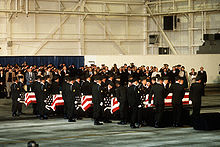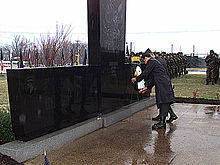Arrow Air Flight 1285R
 DC-8 aircraft similar to Flight 1285[1] | |
| Occurrence | |
|---|---|
| Date | 12 December 1985 |
| Summary | Icing (explosion per minority report) |
| Site | Gander, Newfoundland and Labrador |
| Aircraft type | McDonnell Douglas DC-8-63CF |
| Operator | Arrow Air |
| Registration | N950JW |
| Flight origin | Cairo International Airport |
| Stopover | Cologne |
| Last stopover | Gander International Airport |
| Destination | Fort Campbell |
| Passengers | 248 |
| Crew | 8 |
| Fatalities | 256 |
| Injuries | 0 |
| Survivors | 0 |
Arrow Air Flight 1285 was a McDonnell Douglas DC-8-63CF jetliner, registered N950JW, which operated as an international charter flight carrying U.S. troops from Cairo to their home base in Fort Campbell, Kentucky, via Cologne, Germany and Gander, Newfoundland. On the morning of December 12, 1985, shortly after takeoff from Gander en route to Fort Campbell, the aircraft stalled, crashed and burned about half a mile from the runway, killing all 256 passengers and crew on board.[2]
The accident was investigated by the Canadian Aviation Safety Board (CASB) which determined the probable cause of the crash was the aircraft's unexpectedly high drag and reduced lift condition, which most likely was due to ice contamination on the wings' leading edges and upper surfaces.[3] A minority report stated that the accident could have been caused by an on board explosion of unknown origin prior to impact.[4]
Flight history
The aircraft was chartered to carry U.S. servicemen, mostly members of the 101st Airborne Division, United States Army, from a six-month stay in the Sinai, where they had served in the Multinational Force and Observers peacekeeping force, back to their base in Fort Campbell, Kentucky. The four-engine turbofan aircraft departed Cairo, Egypt on December 11, 1985 at 20:35 UTC, headed to Fort Campbell via Cologne, Germany and Gander.
The aircraft landed at Gander International Airport early in the morning of December 12 at 0905 UTC, where it was refueled and serviced.
Crash sequence

The DC-8 began its take-off roll on runway 22 from the intersection of runway 13 at 06:45 NST/10:15 UTC.[5] It rotated near taxiway "A", 51 seconds after brake release at an airspeed of about 167 KIAS. The aircraft had difficulty gaining altitude after rotation; the airspeed reached 172 KIAS and began to decrease again, causing the DC-8 to descend. After crossing the Trans-Canada Highway at a very low altitude, the pitch angle increased, but the aircraft continued to descend until it struck down-sloping terrain just short of Gander Lake, and crashed approximately 3,000 feet beyond the departure end of the runway. The aircraft broke up and burst into flames, starting a fire that burned for four hours.[2]
Investigation

The Canadian Aviation Safety Board (CASB) investigated the crash, and, under the signature of five of nine board members, found that during its approach toward Gander, precipitation conditions were favorable for the formation of ice on the aircraft's wings. After landing, it continued to be exposed to "freezing and frozen precipitation capable of producing roughening on the wing upper surface" in addition to the freezing temperature. They also found that prior to takeoff the aircraft had not been de-iced.[6] The Board issued the following Probable Cause statement in its final report:[2][3]
The Canadian Aviation Safety Board was unable to determine the exact sequence of events which led to this accident. The Board believes, however, that the weight of evidence supports the conclusion that, shortly after lift-off, the aircraft experienced an increase in drag and reduction in lift which resulted in a stall at low altitude from which recovery was not possible. The most probable cause of the stall was determined to be ice contamination on the leading edge and upper surface of the wing. Other possible factors such as a loss of thrust from the number four engine and inappropriate take-off reference speeds may have compounded the effects of the contamination.
Four members of the CASB dissented, issuing a minority opinion asserting that there was no evidence presented proving that ice had been present on leading edges such as the wings, and the minority report speculated that:[4]
An in-flight fire that may have resulted from detonations of undetermined origin brought about catastrophic system failures.
Aftermath

On the day of the crash, responsibility was claimed by Islamic Jihad, a wing of Hezbollah. The crash came on the second anniversary (1983) of another attack for which Islamic Jihad took credit: the near-simultaneous bombings of six targets in Kuwait, the French and American Embassies among them. Members of Hezbollah had participated in and were jailed for those attacks, but most of the conspirators were members of the Iraqi Shia party al-Dawa, or the Call (today one of the largest political parties in Iraq).
The claim was dismissed by the Canadian and U.S. governments soon afterwards. According to United Press International:
Hours after the crash the Islamic Jihad - a Shiite Muslim extremist group - claimed it destroyed the plane to prove "our ability to strike at the Americans anywhere." Pentagon and Canadian government officials rejected the claim, made by an anonymous caller to a French news agency in Beirut.[7]

256 people died: 248 U.S. servicemen and 8 crew. As of 2008[update], that death toll constituted the deadliest plane crash in Canada[8], and the highest death toll on any day for the U.S. armed forces since World War II, even including combat losses[citation needed].
Of the 248 servicemen, all but twelve were members of 101st Airborne Division (Air Assault), most of whom were from the 3d Battalion, 502d Infantry; eleven were from other Forces Command units; and one was an agent from the Criminal Investigations Command (CID).[9]
A memorial to the 256 victims at the crash site overlooks Gander Lake in Newfoundland, another memorial was erected at Fort Campbell.
See also
References
- ^ Actual photo of accident aircraft on www.airliners.net can be seen here.
- ^ a b c Accident description at the Aviation Safety Network
- ^ a b "CASB Majority Report".
- ^ a b "CASB Minority Report".
- ^ "Gander International Airport Diagram".
- ^ "CASB Majority Report:Findings".
- ^ Watson, Laurie (November 6, 1988). "Errors By Crew Reportedly Cited In Gander Crash". Philadelphia Inquirer, United Press International. p. A33.
{{cite news}}: Check date values in:|date=(help) - ^ "Aviation Safety Network". Retrieved 2006-10-22.
- ^ "Tragedy at Gander". U.S. Army.
External links
- Time Magazine - The Fall of the Screaming Eagles - retrieved 28 Dec 2006
- Time Magazine - Gander: Different Crash, Same Answers - retrieved 28 Dec 2006
- globalsecurity.org - 1989 Congressional Debates on Gander Crash - retrieved 28 Dec 2006
- Fort Campbell Courier - Gander-related news articles - retrieved 28 Dec 2006
- gandercanada.com - Photos of the 20th Anniversary Memorial Service in Gander - retrieved 28 Dec 2006
- CBC News - Ceremonies mark anniversary of deadly Newfoundland air crash - retrieved 28 Dec 2006
- CBC News - Broken Arrow: debate continues after 20 years - retrieved 28 Dec 2006
- rootsweb.com - List of victims - retrieved 28 Dec 2006
- screamingeagle.org - List of victims - retrieved 28 Dec 2006
- screamingeagle.org - Photographs of the Silent Witness Memorial in Gander - retrieved 28 Dec 2006
- Canadian Air Force - The Silent Witness Memorial in Gander - retrieved 28 Dec 2006
- rootsweb.com - Photographs of the Gander Memorial in Hopkinsville, Kentucky - retrieved 28 Dec 2006
- Pre-crash photo of the DC-8 at Airliners.net
